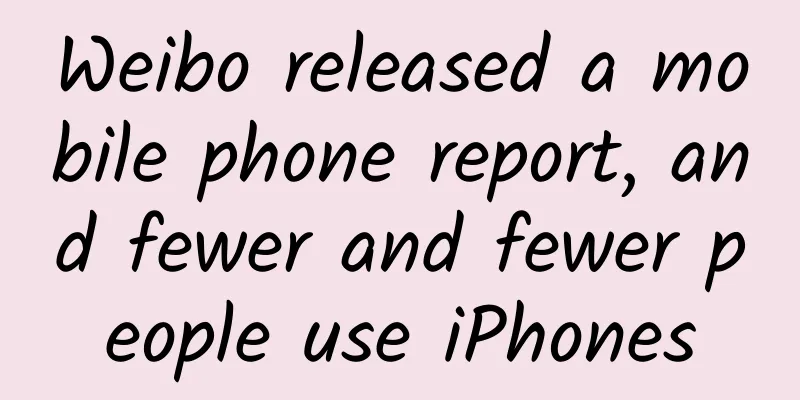Weibo released a mobile phone report, and fewer and fewer people use iPhones

|
There is another new smartphone report, and this time the data is not for shipments, but focuses on user usage behavior. On June 1, Weibo and market research company Canalys jointly released the "2017 Smartphone Micro Report" (hereinafter referred to as the "Report"). The report results come from a quantitative analysis of Weibo users' active behavior data in 2017. Therefore, we can also understand that the scope of this report is "what phones people who use Weibo use", rather than "what phones everyone uses". Given that Weibo's monthly active users have reached 411 million, and mobile devices account for 93%, the actual user usage data recorded by Weibo is still highly referenceable. OV, Huawei, and Xiaomi: Their positions are becoming more stable Judging from the amount of active device brands, although the share of iPhone has been declining every year, it is still the largest, accounting for 30%; OPPO and vivo account for 18% and 16% respectively, ranking the top two among domestic brands, and the ranking is the same as last year; Huawei accounts for 12%, which is an increase compared with last year. Samsung, once the leader in Android, has seen its active share drop to 3%, lower than Meizu. In terms of new additions and retention when changing phones, the share of new iPhone devices has declined, and the retention rate has also dropped by 5% compared to last year; while the new additions and retention of the four major domestic brands have increased, with the retention rates of Huawei and Xiaomi increasing by 9% and 8% respectively. Combining the three sets of data, we can find that although iPhone still accounts for the largest proportion of users, users' intention to choose a new iPhone when replacing a new phone has declined. On the contrary, more and more people are choosing Huawei, OPPO, vivo, and Xiaomi, and the total number of active devices from these four brands has reached 55%, exceeding the total of other brands. This conclusion is also reflected in the data on replacement trends in the report. Whether it is Android or iOS users, the proportion of choosing iPhone when replacing a new phone is decreasing, and according to data from previous years, the proportion of Android users choosing Apple has been declining for three consecutive years. However, the willingness of iOS users to replace their phones with Huawei, OPPO, vivo, and Xiaomi has increased by 3%, 2%, 1%, and 1%, respectively, which also reflects that Weibo users' loyalty to iOS has declined. It is also possible that Apple users no longer like to browse Weibo? But in the final analysis, whether looking at the number of active devices and replacement rates of Weibo users or the shipment volume, the four major domestic mobile phone brands have caused a considerable impact on Apple. According to a report released by IDC in May, Huawei shipped 21.2 million units in the first quarter of 2018, accounting for 24.2% of the Chinese market share, while OPPO, vivo, Xiaomi, and Apple accounted for 18.9%, 16.3%, 15.1%, and 11.3% respectively. This is not much different from the market share ranking in Q4 2017. In the Android camp, the market positions of OV, Huawei, and Xiaomi have become increasingly stable, and the market share of "other" mobile phone manufacturers is even lower than that of Huawei, which ranks first. Shipment volume and market share will further affect the voice of each manufacturer in the supply chain and sales channels. In the future, "Others" will have a harder time than in previous years. They will not seek to shake the position of the four major brands, but only to survive in the cracks. OV users show love, Xiaomi and Huawei users doge face The report also released several sets of small data on the portraits of Weibo mobile phone users. The new iPhone users are mostly female, aged between 19 and 39, and are mostly from first- and second-tier cities. The user portraits of the new OPPO and vivo phones are similar, with slightly more women and most of them in small and medium-sized cities. It seems that it will take some time for the label of "factory girl" to be completely removed. The situation is just the opposite for Huawei and Xiaomi. Mainstream models such as Huawei P10, Honor 9, and Xiaomi 6 are mainly used by male users, and most of them live in third-tier and above cities. The data on emoticons is also very interesting. Vivo and OPPO users like to send love (although this emoticon only reminds me of star chasers and movie sellers), while Xiaomi, Huawei, Samsung, and Meizu users like to send "annoying dog". "Laughing and crying" and "spreading hands" are also very popular emoticons. Life on the Internet is really helpless. |
>>: Here's why Siri is hard to use, and it's about to be solved
Recommend
Teach you how to create explosive short videos and easily monetize them
01 Changes in the communication model: From manua...
Double Eleven pre-sales exceeded 20 billion: How did Li Jiaqi and Wei Ya create huge GMV?
On the first day of Double Eleven pre-sale, Li Ji...
Yang Kai's half-year video course on institutional trading strategy improvement class from June to December 2021
Yang Kai's half-year video course on institut...
List of currently closed communities in Shenyang in 2022: How many communities are closed now? Attached is the latest list!
Recently, new cases have appeared in Shanghai, Be...
The movement of particles is certain, so the future world is certain?
© Malte Mueller/Getty Images Leviathan Press: Tho...
How can we as a self-media person receive and complete more orders?
In general, I think, first of all, you must dare ...
Douyin and WeChat Reading violate users’ personal information (with original text)
Douyin and WeChat Reading violated user personal ...
Danzhou SEO training: How to promote mobile websites? How to optimize mobile SEO?
In many cases, after people optimize their websit...
World Asthma Day丨How can we breathe more comfortably and freely?
Today (May 3) is World Asthma Day. In recent year...
The latest Google Admob channel promotion strategy in 2015
According to statistics, taking Android as an exam...
World Milk Day - Learn about the nutritional value of milk and tips on how to choose it
Copyrighted images from the gallery, unauthorized...
The H5 jointly created by the Palace Museum and Tencent has been popular on WeChat Moments for two days. What’s so good about it?
Here's what happened. From yesterday afternoo...
How to leverage the Apple Store to promote your own App?
In addition to delivering a good product, how can...
How to memorize words: International Phonetic Symbols + Phonics
: : : : : : : : : : : : : : : : : : : : : : : : : ...
The "big questions" of TikTok's live broadcast room "Mastering TikTok's core technology" to seize the dividends of the global live broadcast era
The "big questions" of TikTok's liv...









